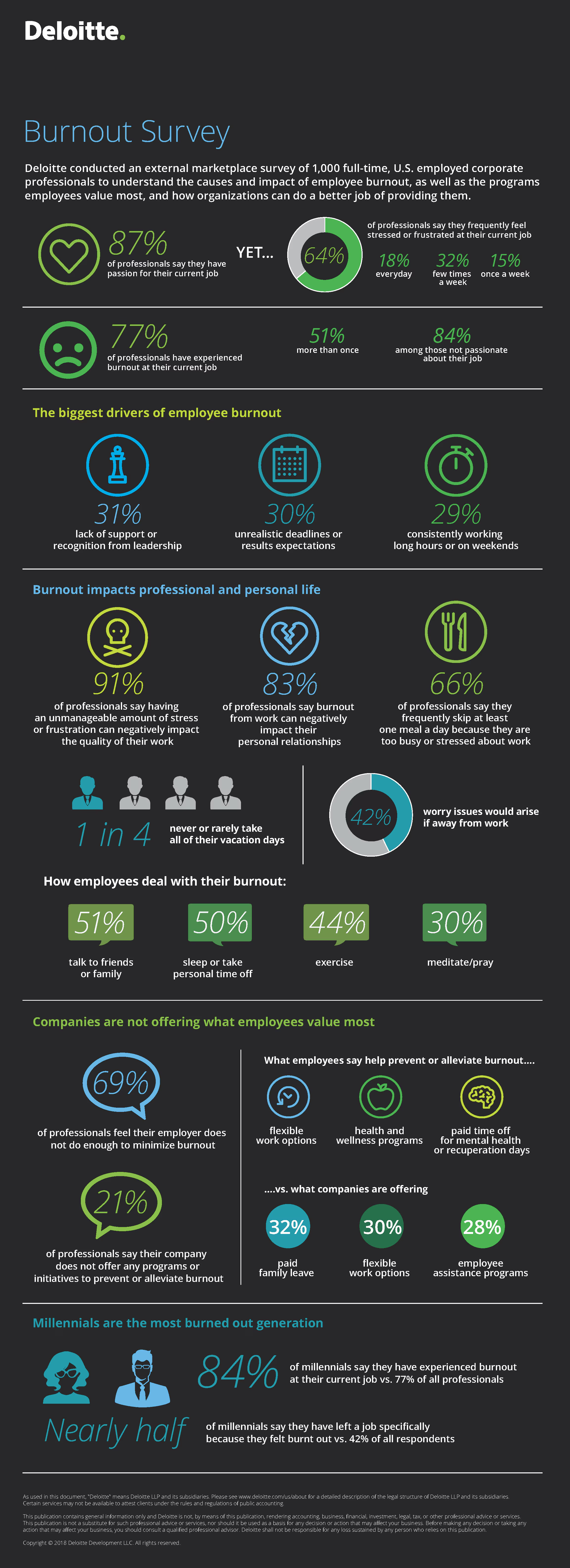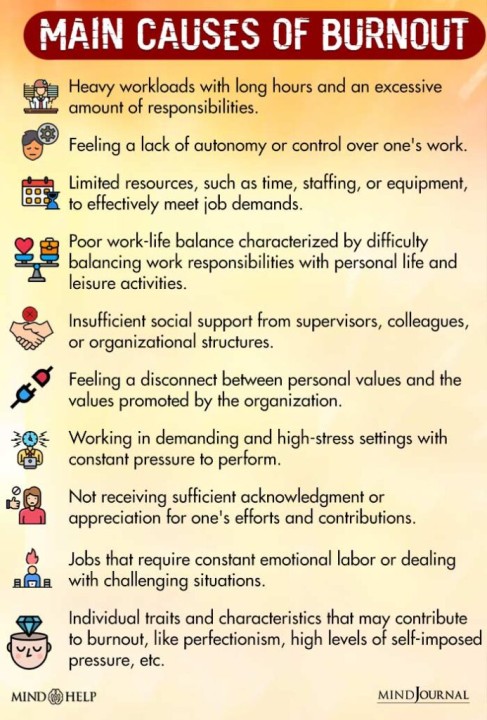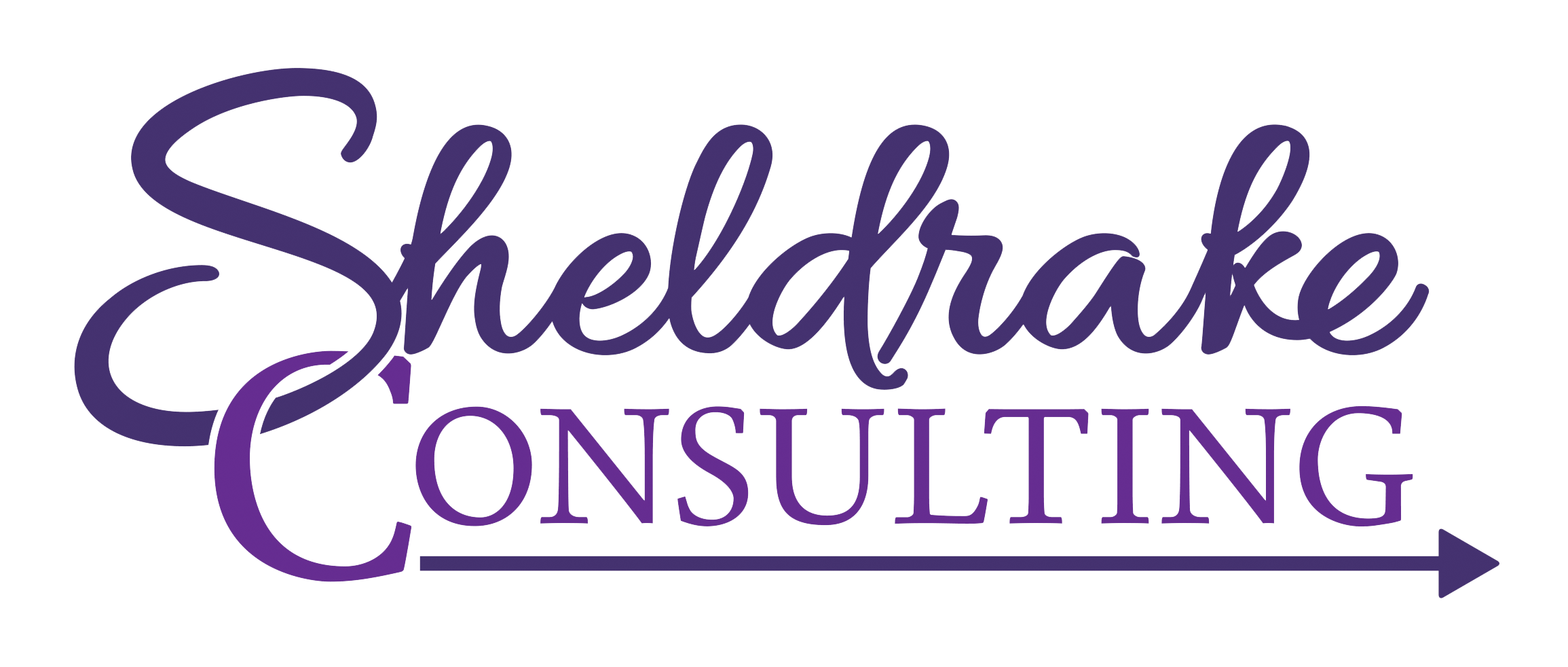When employees are “always on” it’s a recipe for burnout. But what’s the solution? With 77% of professionals experiencing burnout (according to a Deloitte survey), it’s time to look at the causes of burnout and what we can do to help you reclaim your life. And if you’re in a leadership position, this is an important look at how you might be able to help alleviate burnout from the inside.

What is Burnout?
Burnout is a state of chronic physical and emotional exhaustion, often accompanied by feelings of cynicism and detachment from work. Common symptoms include fatigue, irritability, and a sense of ineffectiveness. Deloitte’s recent study on burnout provided startling results proving this is a widespread problem. Here are some of the statistics they shared:
- 91% of respondents say having an unmanageable amount of stress or frustration negatively impacts the quality of their work.
- 83% of respondents say burnout from work can negatively impact their personal relationships.
- 87% of professionals surveyed say they have passion for their current job but 64% say they are frequently stressed, dispelling the myth that passionate employees are immune to stress or burnout.
- Nearly 70% of professionals feel their employers are not doing enough to prevent or alleviate burnout within their organization.
- 21% of respondents say their company does not offer any programs or initiatives to prevent or alleviate burnout.
- One in four professionals say they never or rarely take all of their vacation days. The top driver of burnout cited in the survey is lack of support or recognition from leadership, indicating the important role that leaders play in setting the tone.
- 84% of millennials say they have experienced burnout at their current job, compared to 77% of all respondents.
- Nearly half of millennials say they have left a job specifically because they felt burned out, compared to 42% of all respondents.

What Causes Burnout?
To beat burnout, we first need to get to the root causes of why burnout is so prevalent in the workplace. You hear a lot of talk about self-care, but mindfulness and exercise, while helpful, can only address some of the side effects of burnout, but they don’t solve the underlying causes. How does burnout start? Does everyone experience burnout at some point? Is it an inevitable part of a growing business or team?
Unmanageable Workload – This is usually the first cause that comes to mind when you think about burnout. Consistently high workloads and unrealistic expectations are the primary drivers of burnout. The pressure to meet excessive demands can lead to physical and mental exhaustion. Companies would rather give you summer hours and buy lunch for the team than expand their headcount to decrease workload burnout.
Lack of Support or Recognition from Leadership – When employees feel unsupported or unrecognized by their leaders, it can lead to feelings of isolation and undervaluation. This lack of acknowledgment can cause chronic stress and decreased job satisfaction. Poor leadership comes from the top down, with many top executives experiencing burnout themselves.
Workplace Culture – A high-pressure, ‘always-on’ culture exacerbates burnout. Lack of boundaries and insufficient downtime prevent employees from recovering from stress, leading to chronic fatigue and burnout. With email, Slack, Teams, remote work, and the endless ways we must communicate, it’s no wonder that people can’t seem to turn work off when they’re at home. Culture is a leadership and team effort and must continue being enforced by everyone to take hold.
Lack of Control – Feeling powerless in one’s role due to a lack of autonomy and control over work tasks can cause frustration and helplessness. This psychological stress contributes significantly to burnout. When you’re in a toxic work situation and feel like you can’t quit, this can increase your feelings of burnout.
Insufficient Work-Life Balance – Poor work-life balance, such as not taking vacation days or constantly working overtime, leads to burnout. Over time, this imbalance affects personal health and relationships. The best companies force you to take all of your PTO and provide sufficient team support to back you up when you’re out.

While it might seem that you are pushing your team harder, this type of workload and stress is not sustainable. Eventually, burnout reduces productivity, creativity, and job performance. It also takes a toll on mental and physical health, affecting personal relationships and overall well-being. Think about how a company might develop long-term employees who have a wealth of expertise and bring high value to your organization. You only get these types of employees by cultivating them over time. If you have a culture that has an annual turnover, you will never get the benefits of that expertise and long-term relationship building. In fact, you might be spending more resources on training people instead of becoming more efficient.
Battling Burnout
Burnout is an epidemic in today’s culture, and it might be impossible for one person to break the cycle, but this is why you must become a strong advocate for yourself and your team. Setting your boundaries and reinforcing them is of the utmost importance in the ongoing fight against burnout. Here are a few of my tips on how you can keep burnout at bay:
Set Clear Work Hours – DO.NOT.BRING.WORK.HOME.WITH.YOU. Full stop. When you take a job, make sure you’re clear on the hours you are expected to be on and available. Make sure you aren’t doing work during off hours. There might be times during a special event when you need to make an exception, but this shouldn’t be the rule. You also should be the advocate for your team on this. If you’re the leader, it’s your responsibility to set the example and hold everyone accountable. If someone does need to be available during off hours, set a schedule and have your team rotate on availability so the responsibility doesn’t fall on one person only.
Communicate Goals and Priorities – If you’re constantly given extra work that isn’t in your job description, you need to get in the habit of asking what project your boss wants you to deprioritize to move the new project to the top of the list. Get this in writing. If you’re in leadership, double-check that you aren’t always handing extra work to the same person. Make a conscious effort to rotate the extra work to the entire team and start thinking about what conditions you need to meet to be able to hire someone else if the workload continues to increase.
Take Your PTO – If you’re the boss, make sure you check in with the team around July to ensure they have their PTO scheduled for the year. Encourage them to take it and bring it up during your one-on-one meetings. Develop a standardized process for the team so everyone knows how they should prepare for being out of the office. Then set the precedent that nobody calls or emails the person while on vacation. If you’re the employee, start planning your PTO in Q1 and understand who your backup will be while you’re gone. Create a one-pager of what daily tasks they need to assume in your stead.

Seek Feedback – If leadership never recognizes you, then it might be time to take matters into your own hands. Set up a meeting with your boss and review your goals for the year. Ask for feedback and find out what they are looking for. If you’re the leader, you can get creative with recognition. You might not be able to hand out raises or promotions, but you can implement a team shoutout program or publicly recognize someone for a job well done.
Get Creative – When we are in a toxic cycle of burnout, it can be hard to remember what we loved about our job or career in the first place. It can also be hard to find the joy in life and remember what it’s all about. It’s important to find a creative outlet during this time. It might be adult coloring books, a book club, gardening, painting, crafting, etc. Doing something creative can be a great stress reliever, but it also gets your creative juices flowing and helps you balance the burnout you’re experiencing. It’s by no means a solution but getting into a creative flow with something else will bring numerous benefits to your day-to-day life.
Ask for Help – If you’re experiencing burnout, reflect on its causes and consider how career coaching can help. I would love to help you explore personalized strategies for overcoming burnout and reclaiming your passion and productivity. Understanding the root causes of burnout is the first step in addressing it. With support, you can implement effective strategies to overcome burnout and achieve a fulfilling career. Don’t let burnout hold you back—take the first step toward a healthier, more productive future today.

